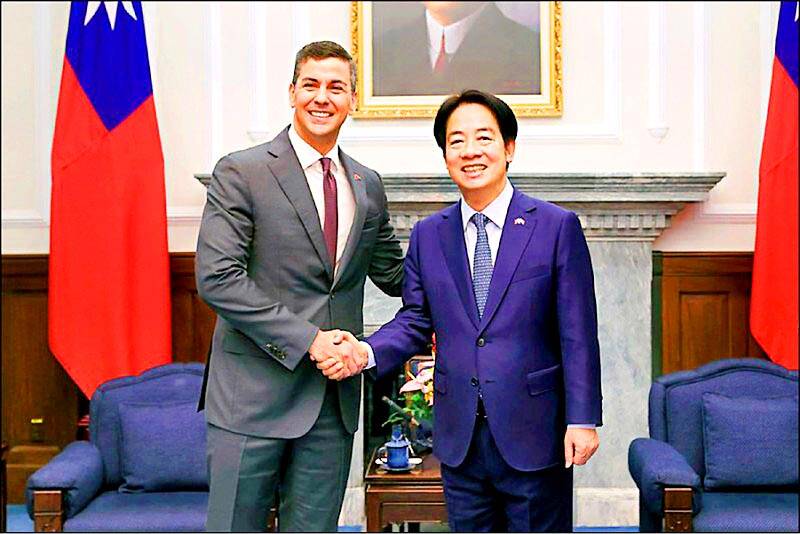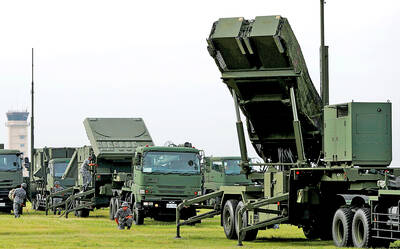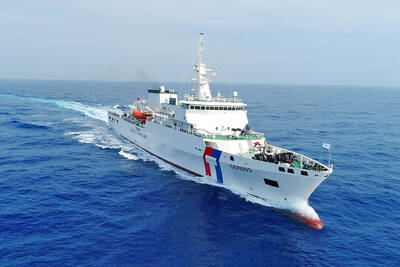Paraguay is preparing to welcome President William Lai (賴清德) next month, Paraguayan President Santiago Pena said on Monday. Lai’s trip would likely involve transiting in the US.
Paraguay is one of only 12 countries to maintain formal diplomatic ties with Taiwan, and the only one in South America.
Taiwanese media, citing an unnamed source, yesterday reported that Lai plans to make stopovers in New York and Dallas, Texas, during state visits next month to Taiwan’s allies in Central and South America, including Paraguay, Guatemala and Belize.

Photo courtesy of the Presidential Office
Visits by Taiwanese presidents to Central and South America always involve what are officially only stopovers in the US given the distance from Taiwan, but are often the most important parts of the trip, as Washington is the nation’s top international backer and arms supplier.
Pena, speaking at a bilateral investment conference in Asuncion, said that Lai would be coming next month.
“We are preparing anxiously and with much affection to receive President Lai in 30 days,” Pena told the conference, which Minister of Foreign Affairs Lin Chia-lung (林佳龍) attended.

Photo: EPA
Belize is also to host Lai during a planned visit to the region, a government official told Reuters, without giving a date.
Taiwan has a handful of other allies in Latin America and the Caribbean, but several have cut ties in recent years in favor of relations with economic powerhouse China.
“This is to show the world that small countries have the capacity to become major global players,” Pena added.
Lai has yet to go to the US since US President Donald Trump took office for the second time earlier this year.
Presidential Office spokesperson Karen Kuo (郭雅慧) declined to comment, except to say that it would make a public announcement if the visits are confirmed.
The Ministry of Foreign Affairs yesterday said that diplomatic allies inviting the president to visit their country demonstrate their close relationship, and arranging officials’ overseas visits has always been an important job of the ministry.
It added that it has no information about presidential visits overseas, and any confirmed visit would be announced by the Presidential Office.
The US Department of State on Monday evening said that any stopovers by Lai would be “in line with past practice, and fully consistent with our long-standing policy.”
In an e-mailed response to the Central News Agency’s question about US policy on Taiwanese presidential transits, the US Department of State said that stopovers by high-level Taiwanese officials are “undertaken with consideration for the safety, comfort, convenience and dignity of the passenger.”
On Friday last week, US Secretary of State Marco Rubio told reporters after meeting with Chinese Minister of Foreign Affairs Wang Yi (王毅) in Malaysia that Wang had not warned him against “welcoming” Lai.
Lai in December visited the Marshall Islands, Tuvalu and Palau, stopping over in Hawaii and Guam.
As then-president Tsai Ing-wen’s (蔡英文) vice president, he had also attended Pena’s presidential inauguration in 2023, with a stopover in New York City.
Lai attended a Taiwanese diaspora event alongside then-American Institute in Taiwan (AIT) chair Laura Rosenberger, former US secretary of homeland security Janet Napolitano and Phoenix Mayor Kate Gallego.
That Washington allowed Lai to arrive via a regular China Airlines flight, deployed police to escort him to the hotel and arranged senior officials to accompany him to local events were considered visible signs of improved ties between Taiwan and the US.
Chinese Nationalist Party (KMT) Legislator Lai Shyh-bao (賴士葆) said the party supports the president’s efforts to increase Taiwan’s visibility in the global arena.
However, the Lai administration would be solely responsible for whatever reception he receives during his US transit, he added.
Additional reporting Chen Yun, Lin Hsin-han and Jonathan Chin

MILITARY BOOST: The procurement was planned after Washington recommended that Taiwan increase its stock of air defense missiles, a defense official said yesterday Taiwan is planning to order an additional four PAC-3 MSE systems and up to 500 missiles in response to an increasing number of missile sites on China’s east coast, a defense official said yesterday. The official, who spoke on condition of anonymity, said that the proposed order would be placed using the defense procurement special budget, adding that about NT$1 trillion (US$32,88 billion) has been allocated for the budget. The proposed acquisition would include launchers, missiles, and a lower tier air and missile defense radar system, they said The procurement was planned after the US military recommended that Taiwan increase

POLITICAL AGENDA: Beijing’s cross-strait Mid-Autumn Festival events are part of a ‘cultural united front’ aimed at promoting unification with Taiwan, academics said Local authorities in China have been inviting Taiwanese to participate in cross-strait Mid-Autumn Festival celebrations centered around ideals of “family and nation,” a move Taiwanese academics said politicizes the holiday to promote the idea of “one family” across the Taiwan Strait. Sources said that China’s Fujian Provincial Government is organizing about 20 cross-strait-themed events in cities including Quanzhou, Nanping, Sanming and Zhangzhou. In Zhangzhou, a festival scheduled for Wednesday is to showcase Minnan-language songs and budaixi (布袋戲) glove puppetry to highlight cultural similarities between Taiwan and the region. Elsewhere, Jiangsu Province is hosting more than 10 similar celebrations in Taizhou, Changzhou, Suzhou,

TWO HEAVYWEIGHTS: Trump and Xi respect each other, are in a unique position to do something great, and they want to do that together, the US envoy to China said The administration of US President Donald Trump has told Chinese President Xi Jinping (習近平) “we don’t want any coercion, but we want [the Taiwan dispute] resolved peacefully,” US ambassador to China David Perdue said in a TV interview on Thursday. Trump “has said very clearly, we are not changing the ‘one China’ policy, we are going to adhere to the Taiwan Relations Act, the three communiques and the ‘six assurances’ that were done under [former US president Ronald] Reagan,” Perdue told Joe Kernen, cohost of CNBC’s Squawk Box. The act, the Three Joint Communiques and the “six assurances” are guidelines for Washington

DEEPENING TIES: The two are boosting cooperation in response to China’s coercive actions and have signed MOUs on search-and-rescue and anti-smuggling efforts Taiwan and Japan are moving to normalize joint coast guard training and considering the inclusion of other allies, the Japanese Yomiuri Shimbun reported yesterday. Both nations’ coast guards in June sent vessels to the seas south of the Sakishima Islands to conduct joint training, the report said, adding that it was the second joint maritime training exercise since the nations severed formal diplomatic ties in September 1972. Japan dispatched the Nagoya Coast Guard’s Mizuho, a 134m, 6,000-tonne patrol vessel which can carry a helicopter, while the Coast Guard Administration (CGA) sent the 126m, 4,000-tonne Yunlin, one of its largest vessels, the report